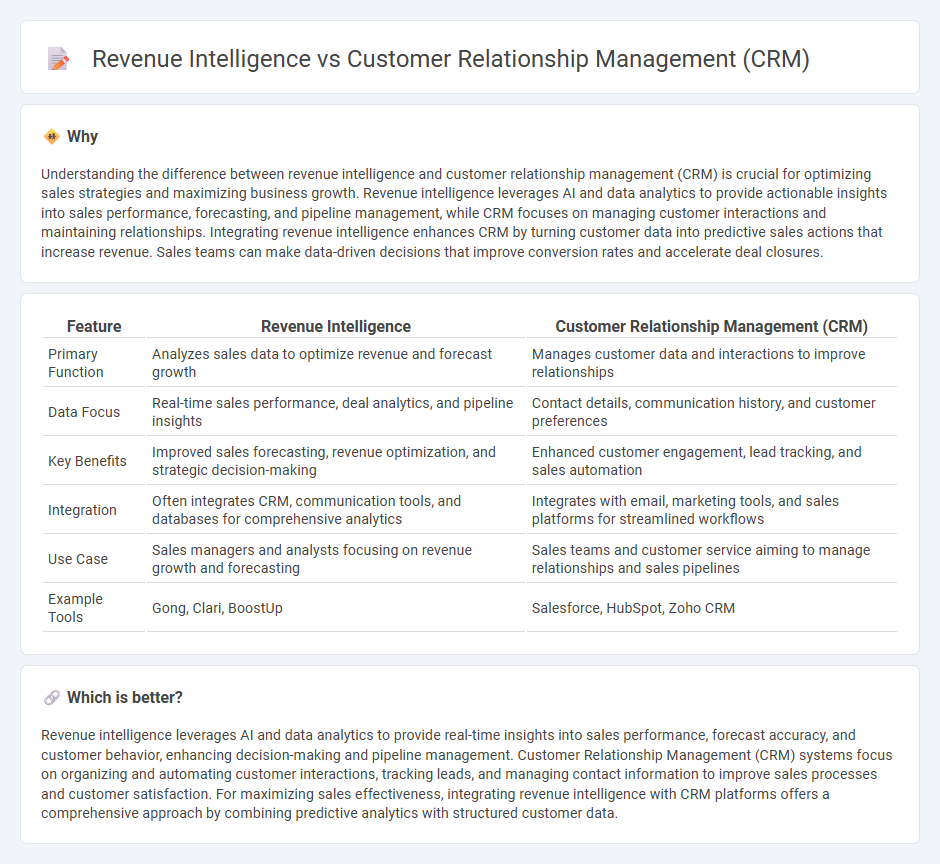
Revenue intelligence integrates data analytics and AI to deliver actionable insights directly into the sales process, enhancing forecasting accuracy and deal management beyond traditional CRM capabilities. Customer Relationship Management (CRM) systems primarily focus on organizing customer data and tracking interactions, while revenue intelligence platforms analyze this data to uncover hidden revenue opportunities and optimize sales strategies. Discover how combining revenue intelligence with CRM can transform sales performance and drive growth.
Why it is important
Understanding the difference between revenue intelligence and customer relationship management (CRM) is crucial for optimizing sales strategies and maximizing business growth. Revenue intelligence leverages AI and data analytics to provide actionable insights into sales performance, forecasting, and pipeline management, while CRM focuses on managing customer interactions and maintaining relationships. Integrating revenue intelligence enhances CRM by turning customer data into predictive sales actions that increase revenue. Sales teams can make data-driven decisions that improve conversion rates and accelerate deal closures.
Comparison Table
| Feature | Revenue Intelligence | Customer Relationship Management (CRM) |
|---|---|---|
| Primary Function | Analyzes sales data to optimize revenue and forecast growth | Manages customer data and interactions to improve relationships |
| Data Focus | Real-time sales performance, deal analytics, and pipeline insights | Contact details, communication history, and customer preferences |
| Key Benefits | Improved sales forecasting, revenue optimization, and strategic decision-making | Enhanced customer engagement, lead tracking, and sales automation |
| Integration | Often integrates CRM, communication tools, and databases for comprehensive analytics | Integrates with email, marketing tools, and sales platforms for streamlined workflows |
| Use Case | Sales managers and analysts focusing on revenue growth and forecasting | Sales teams and customer service aiming to manage relationships and sales pipelines |
| Example Tools | Gong, Clari, BoostUp | Salesforce, HubSpot, Zoho CRM |
Which is better?
Revenue intelligence leverages AI and data analytics to provide real-time insights into sales performance, forecast accuracy, and customer behavior, enhancing decision-making and pipeline management. Customer Relationship Management (CRM) systems focus on organizing and automating customer interactions, tracking leads, and managing contact information to improve sales processes and customer satisfaction. For maximizing sales effectiveness, integrating revenue intelligence with CRM platforms offers a comprehensive approach by combining predictive analytics with structured customer data.
Connection
Revenue intelligence integrates data analytics with customer relationship management (CRM) systems to provide actionable insights that enhance sales strategy and forecasting accuracy. By leveraging CRM data on customer interactions, pipeline stages, and deal progress, revenue intelligence tools identify trends and risks, enabling sales teams to optimize engagement and close deals more effectively. This connection drives increased revenue growth through informed decision-making and improved alignment across sales, marketing, and customer success functions.
Key Terms
**Customer Relationship Management (CRM):**
Customer Relationship Management (CRM) systems centralize customer data to enhance sales, marketing, and service efficiency by tracking interactions and managing leads throughout the buyer's journey. CRM platforms improve customer retention and satisfaction by providing detailed insights into customer preferences and behavior patterns. Explore how leveraging CRM tools can transform your customer engagement and drive business growth.
Contact Management
Customer Relationship Management (CRM) systems centralize contact management by storing detailed customer information, tracking interactions, and facilitating personalized communication. Revenue intelligence enhances this by analyzing contact data to uncover revenue opportunities and predict sales outcomes through AI-driven insights. Explore how integrating CRM and revenue intelligence can optimize your contact management strategy for better sales performance.
Sales Pipeline
Customer Relationship Management (CRM) systems primarily organize and track customer interactions, sales activities, and pipeline stages to enhance relationship building and forecast accuracy. Revenue intelligence tools analyze sales pipeline data using AI-driven insights to identify trends, predict deal outcomes, and optimize revenue generation strategies. Explore detailed comparisons to understand how each solution impacts sales pipeline efficiency and revenue growth.
Source and External Links
What is CRM (Customer Relationship Management)? - TechTarget - CRM is a combination of practices, strategies, and technologies used by companies to manage and analyze customer interactions and data throughout the customer lifecycle, aiming to improve service, retention, and sales growth.
What Is CRM? | IBM - CRM is a set of integrated technologies that help organizations document, track, and manage their relationships and interactions with both existing and potential customers, supporting sales processes and lead management.
What is CRM (customer relationship management)? Full guide - CRM is a tool that helps sales teams track and drive revenue while maintaining and improving customer relationships by centralizing customer interactions and automating sales activities.
 dowidth.com
dowidth.com